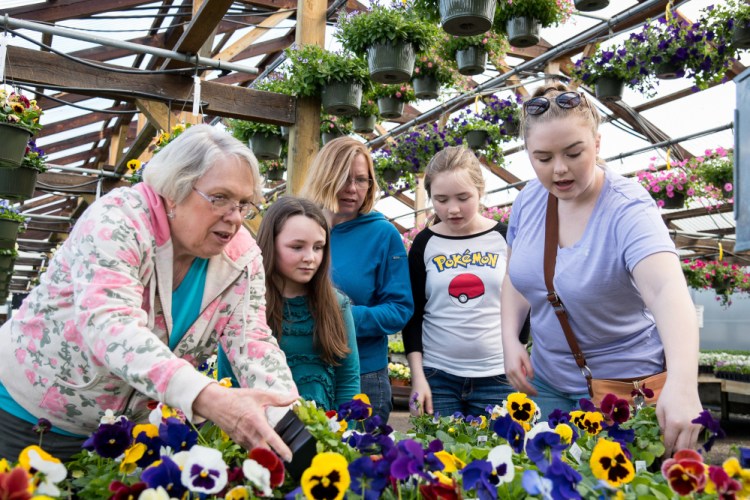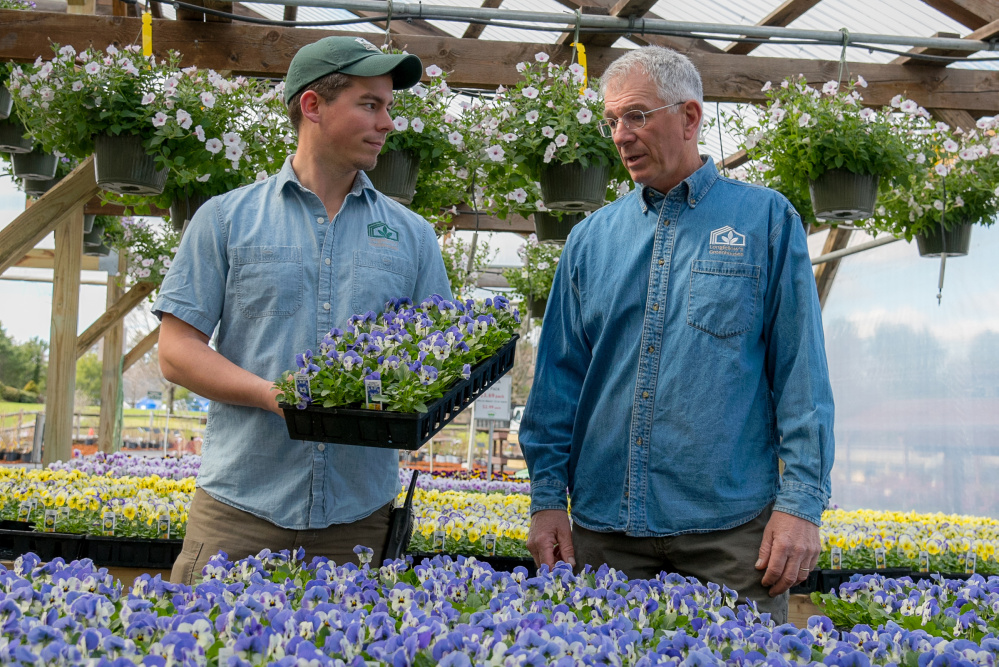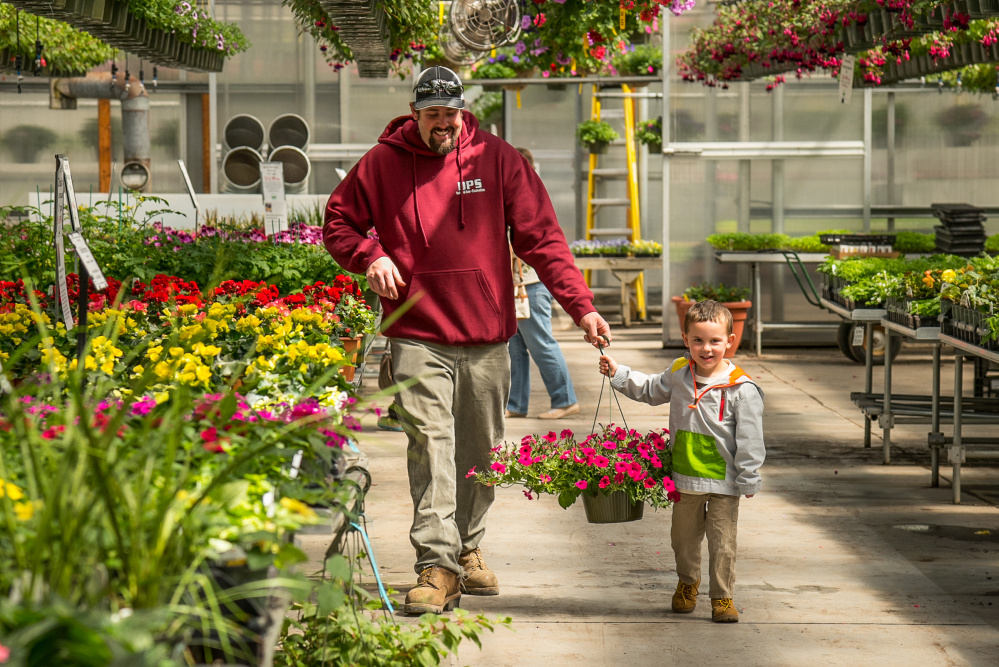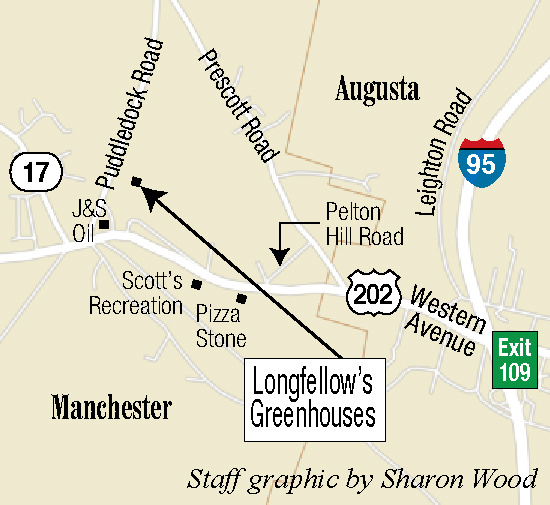MANCHESTER — When Scott Longfellow first helped his parents open a greenhouse business in 1977, he didn’t think he’d work there more than a couple years, and he also thought his father’s decision to start the business with 12 greenhouses was too ambitious.
“It seemed crazy,” he said of the largeness of the business plan hatched by his parents, Lawrence and Mavis Longfellow.
The severely cold winter of 1976-1977 made the odds of Longfellow’s Greenhouses succeeding seem even slimmer, but the business took off, proving Scott wrong on multiple counts. After working for his parents for a decade, he bought the operation and continues to run it with his wife and kids, and the number of greenhouses at the business has more than doubled in that time. As Scott sees it, Lawrence and Mavis capitalized on a landscape gardening trend that was sweeping the nation in the 1970s.
“My parents had a big vision, a grand vision, and it worked,” said Scott Longfellow, who studied horticulture at University of Maine at Orono. He decided to stick with the family business because it “seemed to be exploding” and “the industry seemed to be really increasing dramatically every year.”
Nowadays, the business — which is celebrating its 40th anniversary with an open house this weekend that will include workshops, lectures, raffles and specials — is growing tens of thousands of geraniums, mums, perennials, poinsettias and other flowers, as well as herbs, shrubs and other plants.
Just as landscape gardening was having a moment when Longfellow’s first opened in the 1970s, Scott sees another change happening in the market now: as the U.S. economy has bounced back from the Great Recession, an increasing number of young gardeners have become interested in raising their own edible produce. That’s a welcome development for the gardening industry, which struggled after the recession as Americans bought fewer homes and struggled to make ends meet.
At Longfellow’s Greenhouses, the surge of younger gardeners has led the staff to become more like growing coaches to their customers, advising them on how much light is needed, what types of fertilizer work best and how they should water their plants.
“The gardener of today knows less than our grandparents,” Scott said. “It’s been people who are less connected to agriculture, and have less of an understanding of the basics of gardening. Our goal is to help these people succeed. Gardening is not complicated, but some very basic things need to be known.”
Longfellow’s displays its plants in spacious greenhouses attached to a retail store and also stocks plants that are grown in other parts of the country, as well as seeds, soil, gardening tools and host of other items.
Spending in the U.S. gardening industry first returned to pre-recession levels in 2015 and hit $36.9 billion in 2016, according to the National Gardening Market Research Company. The group attributed some of that growth to gardeners under the age of 40, according to a news release announcing its findings.
Those findings dovetail with a trend that Caragh Fitzgerald, an agricultural educator at the University of Maine Cooperative Extension in Kennebec County, has observed.
“We see in gardening programs and in the community, anecdotally, a lot of interest in where food comes from,” Fitzgerald said. “We’re seeing that in our younger population, supporting local food production on down to home gardening. We see that some with Cooperative Extension clients, but also with colleges and universities … More schools are putting in school gardens.”
Fitzgerald added, “The issue of food and social justice, all of those things, are much more prominent now than they were even a decade ago.”
On Sunday morning, Scott gave a tour of the greenhouses with his 28-year-old son, Will, who is now general manager of the business. They stopped in one greenhouse with a sea of purple, yellow and white pansies. Sun was beaming inside, making the 50-degree weather feel warmer than it was. A mix of sweet and bitter smells floated through the space.
On a 14-acre property on Puddledock Road, the business includes about 90,000 square feet of growing space and employs around 90 people at the peak of gardening season.
This time of year, many customers want to buy tomato plants and other vegetables ahead of summer, Scott said. But given how low the temperature can swing, he advises customers against tomatoes until later in spring.
“The first frost will kill them,” he said.
Then Scott gestured to the pansies.
“These can be planted now,” he said. “They can be planted outdoors. They like cool temperatures, and they need a half-day in the sun.”
A sign in the pansy section provided additional guidance to customers.
“Please protect these plants,” the sign warned. “If temperatures are expected to dip below 35 degrees, please cover with sheets, towels, layers of newspaper or similar material.”
For some customers in Longfellow’s on Sunday, guidance about where and when to grow plants has been a selling point.
Donna Clark, of Madison, was shopping for forsythias and azaleas on Sunday. She’s been coming to Longfellow’s for 20 years, she said, partly because there is not a commercial greenhouse where she lives, but also because of the extra instructions that come with plants at the Manchester business.
“They give you more information on the plants,” she said, pointing to a tag that indicated which of Maine’s growing zones the azalea plant was best suited for.
But other customers were less focused on buying a particular item and more interested in browsing Longfellow’s large selection.
Carol Haskell, 71, of Bryant Pond, was at Longfellow’s on Sunday with her daughter, Crystal Rouley, 48, of Lisbon Falls, Rouley’s teenage daughters, and a girl who was friends with the family.
The women were not searching for any particular plant, but have a yearly tradition of going to Longfellow’s on Mother’s Day. This year, they decided to go a couple weeks early because of scheduling conflicts. They were browsing the selection of pansies.
“I mostly come for the flowers,” said Bridget Rowley, 16, who has fond memories of the snap dragons she purchased at Longfellow’s when she was younger. “I don’t remember not coming here.”
Longfellow’s has made a name for itself over the years, growing despite the tough competition from big box stores and smaller operations, said Fitzgerald, the agricultural educator at the University of Maine Cooperative Extension.
“That business is certainly one of the leaders in the industry,” Fitzgerald said. “They pay really close attention to the trends.”
Customers come to Longfellow’s from across the state, according to Scott. Some even come from out of state.
“It’s definitely a destination gardener center,” he said. “My son Will, this past December, was loading a Christmas tree onto a car and they asked him to tie it down extra tight, because they were taking it to Virginia … A lot of people know Longfellow’s.”
Charles Eichacker — 621-5642
Twitter: @ceichacker
Copy the Story LinkSend questions/comments to the editors.







Success. Please wait for the page to reload. If the page does not reload within 5 seconds, please refresh the page.
Enter your email and password to access comments.
Hi, to comment on stories you must . This profile is in addition to your subscription and website login.
Already have a commenting profile? .
Invalid username/password.
Please check your email to confirm and complete your registration.
Only subscribers are eligible to post comments. Please subscribe or login first for digital access. Here’s why.
Use the form below to reset your password. When you've submitted your account email, we will send an email with a reset code.